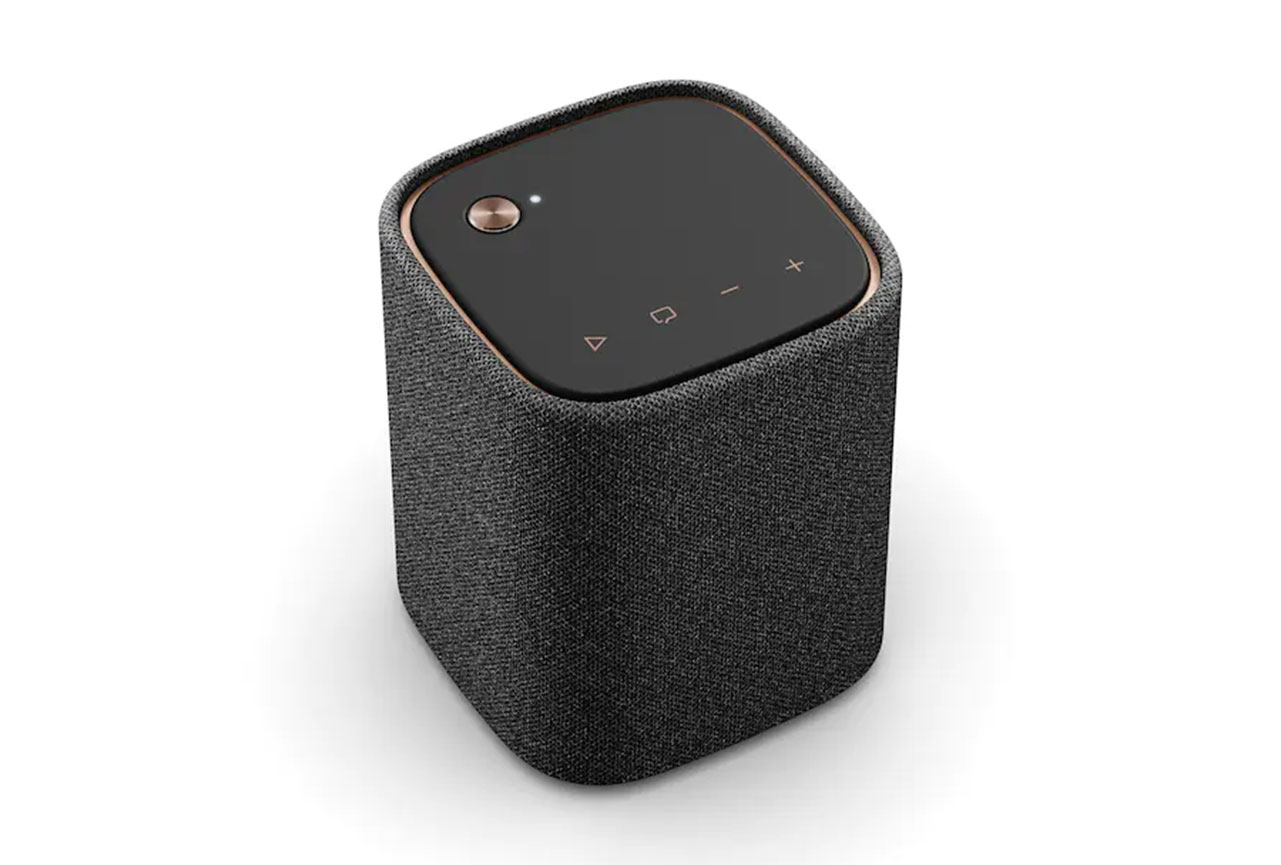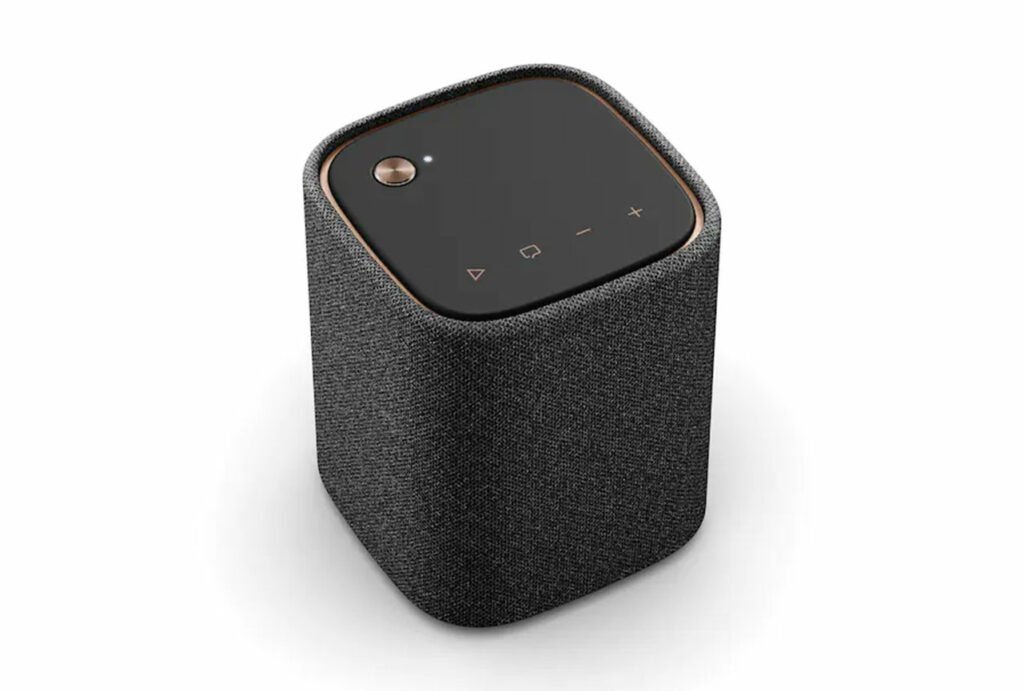We put the Yamaha WS-B1A through our rigorous DXOMARK Audio test suite to measure its performance at playing back audio. In this review, we will break down how it fared in a variety of tests and several common use cases.
Overview
Key specifications include:
- Wireless protocols: Bluetooth
- Wired connectivity: None
- Height: 10.5 cm, Width: 8.8 cm, Depth: 8.8 cm
- Weight: 490.0 g
- Speakers: 1 loudspeaker (55mm) + 2 passive radiators
Test conditions:
- Tested with Motorola G8
- Communication protocol used: Bluetooth
 Yamaha WS-B1A
Yamaha WS-B1A


Pros
- Voice presence
- Pretty loud for its size
Cons
- Aggressive timbre
- Underwhelming in almost every attribute
In our DXOMARK Speaker test, the Yamaha WS-B1A performance was not among the best, with subpar results across nearly all test categories and use cases. Our experts noted the nice voice presence and good loudness at maximum volume. However, volume step distribution was very inconsistent. Timbre was unpleasant, with an inconsistent tonal balance, dynamics results were poor, due to a weak attack and lack of sustain. The monophonic speaker meant that there was no wideness nor stereo balance to assess. Our testers also noticed compression and distortion among other unwanted artifacts.
Listen to the tested speaker’s playback performance in this comparison with its competitors:
Test summary
About DXOMARK Wireless Speaker tests: For scoring and analysis in our wireless speaker reviews, DXOMARK engineers perform a variety of objective tests and undertake more than 20 hours of perceptual evaluation under controlled lab conditions. This article highlights the most important results of our testing. Note that we evaluate playback using only the device’s built-in hardware. (For more details about our Speaker protocol, click here.)
The following section gathers key elements of our exhaustive tests and analyses performed in DXOMARK laboratories. Detailed performance evaluations under the form of reports are available upon request. Do not hesitate to contact us.
The DXOMARK Speaker overall score is derived from a range of sub-scores. In this section, we will take a closer look at timbre, dynamics, spatial, volume, and artifacts, and explain what they mean for the user.

Timbre
Yamaha WS-B1A
152
DXOMARK timbre tests measure how well a speaker reproduces sound across the audible tonal range and takes into account bass, midrange, treble, tonal balance, and volume dependency.
In our tests, the Yamaha WS-B1A did not deliver a pleasant timbre. The slightly inconsistent tonal balance was most likely caused by internal processing, but the resonant and harsh treble rendition was the speaker’s main issue across several use cases and all volume settings. A questionable boost just above the 10kHz range was accompanied by frequency notches slightly below, resulting in blurriness. The harshness issues were emphasized at higher volumes, making for a fairly unpleasant listening experience. Midrange left a lot to be desired in terms of body and warmth. The low midrange was noticeably weaker when compared to the higher midrange frequencies, resulting in a thin and somewhat hollow sound. Our experts also noted a complete lack of bass, especially when playing at low volumes, which had a significant negative impact on the overall experience. The rendition felt incomplete, lacking depth, especially when compared to the excessive and harsh treble mentioned previously.

Dynamics
Yamaha WS-B1A
137
Our dynamics tests measure how well a device reproduces the energy level of a sound source, taking into account attack, bass precision, and punch.
The dynamics performance was very underwhelming. Attack was weak across all use cases and volume settings, and its impact was further diminished by underlying compression issues, as well as excessive upper treble, which was prone to distortion. A lack of sustain resulted in an incorrect low-end rendition in terms of envelope and the lack of low-end extension, combined with dull low midrange energy, resulted in a weak punch rendition.

Spatial
Yamaha WS-B1A
111
Our spatial tests measure a speaker’s ability to reproduce stereo sound in all directions, taking into account localizability, balance, wideness, distance, and directivity. Please note that wideness is 0 on mono speakers and on speakers that cannot deliver a significant stereo effect.
In our tests, the WS-B1A was not perfectly omnidirectional, with a polar pattern showing more treble at the front of the speaker. These measurements were also verified in perceptual evaluation. The speaker is also monophonic, making the assessment of wideness or stereo balance irrelevant. This also means localizability of individual sound sources was poor. On the plus side, distance rendition was mostly accurate, but vocal content could sound too close.

Volume
Yamaha WS-B1A
141
Our volume tests measure both the maximum loudness a speaker is able to produce and how smoothly volume increases and decreases based on user input.
The Yamaha’s performance in the volume category was very poor. Volume step distribution was extremely inconsistent, with a plateau across the first three steps and a ceiling across the last five steps. The 4th and 5th steps were too spaced out, making it difficult to set a proper volume level for quiet listening. The maximum volume was decently loud for a device of the Yamaha’s dimensions.
Here are a few sound pressure levels (SPL) we measured when playing our sample recordings of hip-hop and classical music at maximum volume:
| Correlated Pink Noise | Uncorrelated Pink Noise | Hip-Hop | Classical | Latin | Asian Pop | |
| Yamaha WS-B1A | 84 dBA | 83.8 dBA | 79.6 dBA | 78.6 dBA | 80.8 dBA | 73.9 dBA |
| JBL Charge 5 | 72.2 dBA | 69.3 dBA | 69.9 dBA | 61.4 dBA | 71.6 dBA | 63.7 dBA |
| Sony SRS-XB33 | 84.2 dBA | 81.1 dBA | 81.9 dBA | 74.1 dBA | 82.3 dBA | 75.8 dBA |

Artifacts
Yamaha WS-B1A
133
Our artifacts tests measure how much source audio is distorted when played back, along with such other sound artifacts as noise, pumping effects, and clipping. Distortion and other artifacts can occur both because of sound processing and because of the quality of the speakers.
In terms of unwanted audio artifacts, the Yamaha’s performance was below average. Sound quality was strongly affected by compression, especially at high volume volumes. Our testers also noticed distortion, especially on upper frequencies, which induced harsh sibilance. Objective measurements also showed a fairly high THDN (Total Harmonic Distortion plus Noise) value in the low end above 70dB.



DXOMARK encourages its readers to share comments on the articles. To read or post comments, Disqus cookies are required. Change your Cookies Preferences and read more about our Comment Policy.